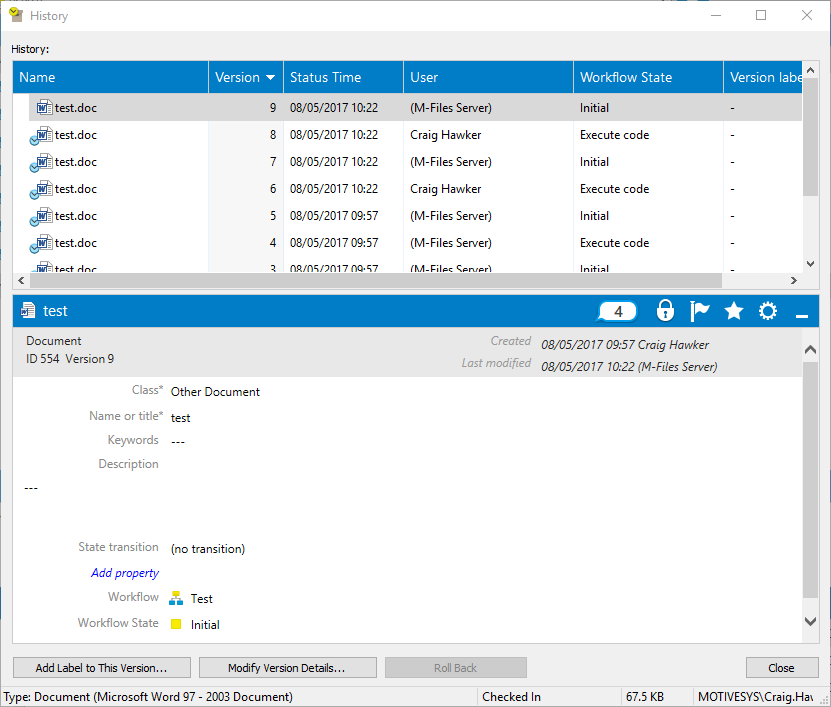Deleting and destroying objects with the COM API
This page focuses on deleting and destroying objects using the COM API. Details on deleting objects using the REST API can be found in the dedicated page.
Deleting vs destroying
When removing objects from an M-Files vault, it is important to decide whether the object should be deleted or destroyed. Deleted objects are simply flagged as deleted and are hidden from most users. Administrators can access these deleted items (and optionally undelete/restore them) by searching for them using the M-Files Desktop client. Destroyed objects (or destroyed versions of an object) are permanently removed from the system and cannot be restored.
Deleting objects
Destroying one or more versions of an object is done by calling DeleteObject.
// Which vault are we connecting to?
var vaultGuid = "{C840BE1A-5B47-4AC0-8EF7-835C166C8E24}";
// Connect to the vault using a client connection.
// ref: http://developer.m-files.com/APIs/COM-API/#api-modes-client-vs-server
// Note: this code will just return the first connection to the vault.
var clientApplication = new MFilesClientApplication();
var vault =
clientApplication
.GetVaultConnectionsWithGUID(vaultGuid)
.Cast<VaultConnection>()
.FirstOrDefault()?
.BindToVault(IntPtr.Zero, true, true);
if(null == vault)
{
throw new NotImplementedException("Vault connection not found");
}
// We want to delete the document with ID 664.
var objID = new MFilesAPI.ObjID();
objID.SetIDs(
ObjType: (int)MFBuiltInObjectType.MFBuiltInObjectTypeDocument,
ID: 664);
// Delete the object.
vault.ObjectOperations.DeleteObject(objID);
Undeleting objects
Objects that are deleted can be undeleted by administrative users either using the M-Files Desktop client, or by calling UndeleteObject.
// Which vault are we connecting to?
var vaultGuid = "{C840BE1A-5B47-4AC0-8EF7-835C166C8E24}";
// Connect to the vault using a client connection.
// ref: http://developer.m-files.com/APIs/COM-API/#api-modes-client-vs-server
// Note: this code will just return the first connection to the vault.
var clientApplication = new MFilesClientApplication();
var vault =
clientApplication
.GetVaultConnectionsWithGUID(vaultGuid)
.Cast<VaultConnection>()
.FirstOrDefault()?
.BindToVault(IntPtr.Zero, true, true);
if(null == vault)
{
throw new NotImplementedException("Vault connection not found");
}
// We want to undelete the document with ID 664.
var objID = new MFilesAPI.ObjID();
objID.SetIDs(
ObjType: (int)MFBuiltInObjectType.MFBuiltInObjectTypeDocument,
ID: 664);
// Undelete the object.
vault.ObjectOperations.UndeleteObject(objID);
Destroying objects
Destroying one or more versions of an object is done by calling DestroyObject.
Destroying specific object versions
Objects within M-Files have at least one version, typically more than one. These versions get automatically incremented as the object is processed within M-Files.

To permanently destroy a specific version of an object - leaving all other versions available - call DestroyObject, ensuring that DestroyAllVersions is set to false, and ObjectVersion is set to the version number that needs to be destroyed.
// Which vault are we connecting to?
var vaultGuid = "{C840BE1A-5B47-4AC0-8EF7-835C166C8E24}";
// Connect to the vault using a client connection.
// ref: http://developer.m-files.com/APIs/COM-API/#api-modes-client-vs-server
// Note: this code will just return the first connection to the vault.
var clientApplication = new MFilesClientApplication();
var vault =
clientApplication
.GetVaultConnectionsWithGUID(vaultGuid)
.Cast<VaultConnection>()
.FirstOrDefault()?
.BindToVault(IntPtr.Zero, true, true);
if(null == vault)
{
throw new NotImplementedException("Vault connection not found");
}
// We want to delete the document with ID 664.
var objID = new MFilesAPI.ObjID();
objID.SetIDs(
ObjType: (int)MFBuiltInObjectType.MFBuiltInObjectTypeDocument,
ID: 664);
// Destroy a specific object version.
vault.ObjectOperations.DestroyObject(
objID,
DestroyAllVersions: false,
ObjectVersion: 1);
Destroying all versions of an object
To permanently destroy all versions of an object call DestroyObject, ensuring that DestroyAllVersions is set to true, and ObjectVersion is set to -1.
// Which vault are we connecting to?
var vaultGuid = "{C840BE1A-5B47-4AC0-8EF7-835C166C8E24}";
// Connect to the vault using a client connection.
// ref: http://developer.m-files.com/APIs/COM-API/#api-modes-client-vs-server
// Note: this code will just return the first connection to the vault.
var clientApplication = new MFilesClientApplication();
var vault =
clientApplication
.GetVaultConnectionsWithGUID(vaultGuid)
.Cast<VaultConnection>()
.FirstOrDefault()?
.BindToVault(IntPtr.Zero, true, true);
if(null == vault)
{
throw new NotImplementedException("Vault connection not found");
}
// We want to delete the document with ID 664.
var objID = new MFilesAPI.ObjID();
objID.SetIDs(
ObjType: (int)MFBuiltInObjectType.MFBuiltInObjectTypeDocument,
ID: 664);
// Destroy all versions of an object.
vault.ObjectOperations.DestroyObject(
objID,
DestroyAllVersions: true,
ObjectVersion: -1);